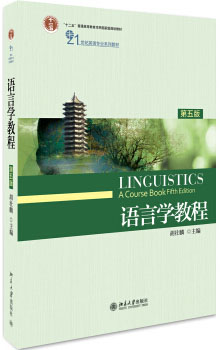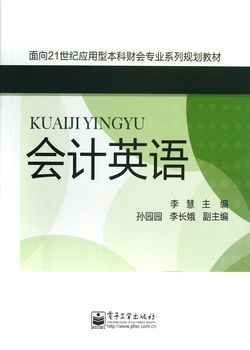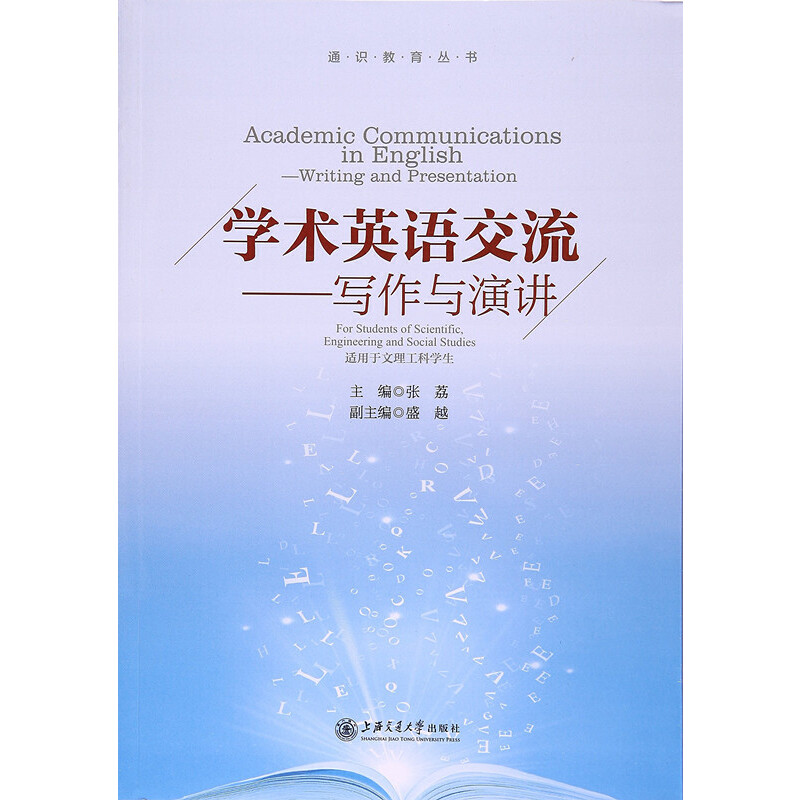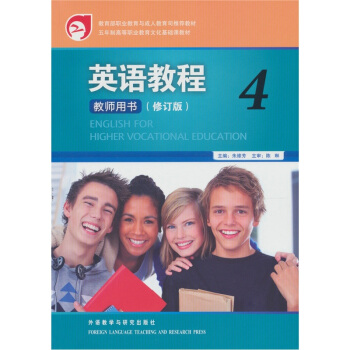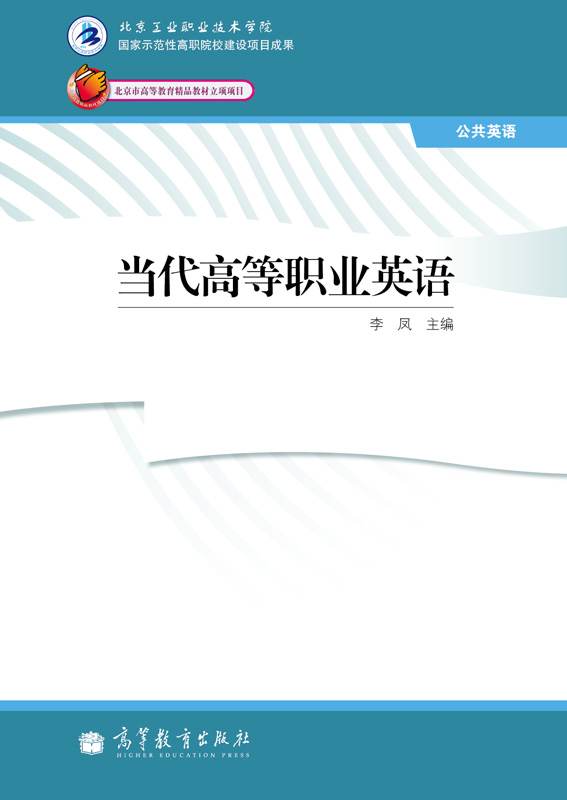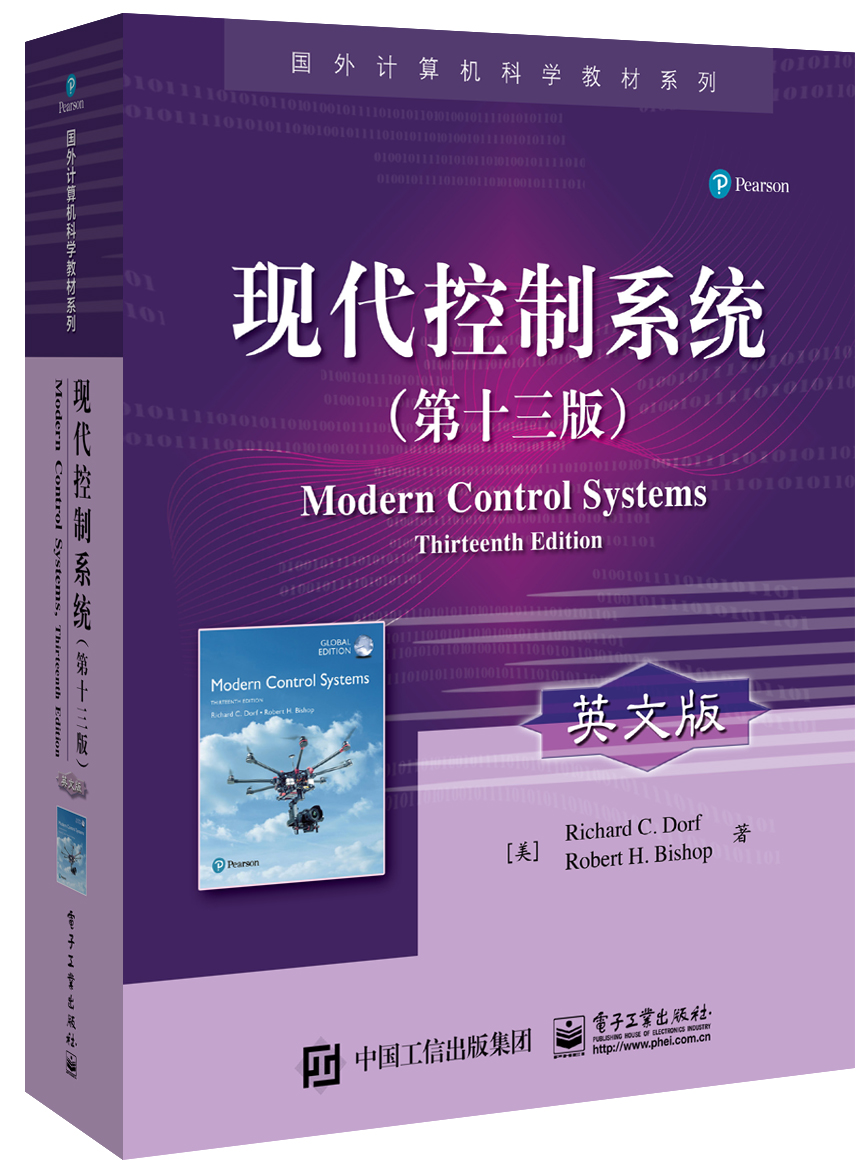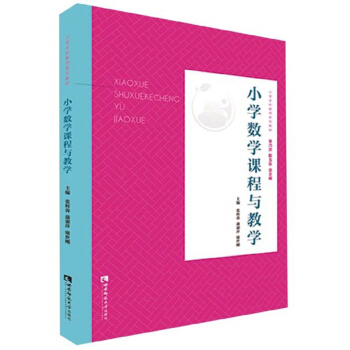英语学术论文写作
定价:¥69.80
作者: 谢剑萍,王晶
出版时间:2023-09
最新印次日期:2023-9
出版社:商务印书馆
- 商务印书馆
- 9787100229265
- 1-1
- 504729
- 44267556-7
- 16开
- 2023-09
- 320
- 文学
- 外国语言文学类
- 公共英语
- 本科
作者简介
内容简介
学术写作是中国高等院校学生必备的一种核心学术能力。当前国际学术论文发表需求日益增长,为适应社会发展新形势对我国研究生和本科生人才培养提出的更高要求、培养和提高我国研究生和高年级本科生的英语学术论文写作能力,以增强我国国际学术竞争力,我们编写了这本《英语学术论文写作》。
本教材适用于我国高等院校不同学科领域的研究生和高年级本科生的英语学术论文写作教学。教材内容的编写主要基于两位主编教师多年的教学经验积累和研究成果。他们在广东外语外贸大学教授英语专业研究生课程“学术论文写作”以及公共英语研究生课程“英语学术写作”多年,已形成一套体系相对完善的讲义,其内容包含了讲授内容、课堂内外活动练习以及拓展阅读材料。该讲义已经过五轮使用,年均授课学生约300人次,教学效果优异。
本教材适用于我国高等院校不同学科领域的研究生和高年级本科生的英语学术论文写作教学。教材内容的编写主要基于两位主编教师多年的教学经验积累和研究成果。他们在广东外语外贸大学教授英语专业研究生课程“学术论文写作”以及公共英语研究生课程“英语学术写作”多年,已形成一套体系相对完善的讲义,其内容包含了讲授内容、课堂内外活动练习以及拓展阅读材料。该讲义已经过五轮使用,年均授课学生约300人次,教学效果优异。
目录
Theme ONE Acquainting Yourself with Academic Writing
Scope of the Theme
CHAPTER 1 Audience, Purpose and Organisation
1.1 General classification of writing
1.2 Writing for different audiences
1.3 Introduction to academic writing
1.4 Major genres and audience of academic writing
1.5 General structure: research paper vs. thesis
1.6 Clarifying essential terms
1.6.1 Research topic
1.6.2 Research problem
1.6.3 Research question
1.6.4 Research purpose
1.6.5 Research hypothesis
Suggested Tasks
Suggested Reading List
References
CHAPTER 2 Style and Presentation
2.1 Stylistic features of English academic writing
2.1.1 Complexity
2.1.2 Formality
2.1.3 Objectivity
2.1.4 Explicitness
2.1.5 Accuracy and conciseness
2.1.6 Caution or tentativeness
2.2 Tenses in English academic writing
2.2.1 Common tenses in research articles
2.2.2 Tense shift
2.3 Mechanics in English academic writing
2.3.1 Definition of mechanics
2.3.2 Spelling
2.3.3 Abbreviation
2.3.4 Punctuation
2.3.5 Capitalisation
2.3.6 Italics
2.3.7 Numbers
2.3.8 Enumeration
Suggested Tasks
Suggested Reading List
References
CHAPTER 3 Flow
3.1 Understanding coherence and cohesion
3.2 Coherence at the macro- and meso-level
3.3 Coherence and cohesion at the micro-level
3.3.1 Standard transitional devices
3.3.2 "Known-new contract"
Suggested Tasks
Suggested Reading List
Reference
Theme TWO Building Academic Integrity
Scope of the Theme
CHAPTER 4 Academic Plagiarism
4.1 Definition of plagiarism
4.2 Types of plagiarism
4.3 Techniques to avoid plagiarism
4.3.1 Paraphrasing and summarising
4.3.2 Direct quotation
4.3.3 Indirect citation
4.3.4 Referencing format
Suggested Tasks
Suggested Reading List
References
CHAPTER 5 Argumentation
5.1 Definition of an argument
5.2 Making a good argument
5.2.1 Basing claims on reasons
5.2.2 Basing claims on evidence
5.2.3 Even-handed arguments
5.3 General framework for building an argument
5.4 The language of argumentation
Suggested Tasks
Suggested Reading List
References
Theme THREE "Windows and Doors"
Scope of the Theme
CHAPTER 6 Title, Abstract and Keywords
6.1 Title
6.1.1 Attributes of a good title
6.1.2 Types of title
6.1.3 A formula of a good title
6.2 Abstract
6.2.1 Importance and purposes of Abstract
6.2.2 Types of Abstract
6.2.3 Generic structure of Abstract
6.2.4 Language in Abstract
6.2.5 Argument in Abstract
6.2.6 Common problems of writing Abstract
6.3 Keywords
6.4 Samples from multiple disciplines
Suggested Tasks
Suggested Reading List
References
CHAPTER 7 Introduction
7.1 Functions of Introduction
7.2 Generic structure of Introduction
7.2.1 Move 1: Establishing a research territory
7.2.2 Move 2: Establishing a research niche
7.2.3 Move 3: Occupying the niche
7.2.4 Research article introduction vs. thesis introduction
7.3 Common problems of writing Introduction
7.4 Samples from multiple disciplines
Suggested Tasks
Suggested Reading List
References
CHAPTER 8 Conclusion
8.1 Functions of Conclusion
8.2 Generic structure of Conclusion
8.2.1 A reader-friendly summary of findings
8.2.2 Contribution of the findings to the field
8.2.3 Limitations
8.2.4 Recommendation for further research
8.3 Argument in Conclusion
8.4 Common problems of writing Conclusion
8.5 Abstract vs. Introduction vs. Conclusion
8.5.1 Differences in content
8.5.2 Differences in language
8.6 Samples from multiple disciplines
Suggested Tasks
Suggested Reading List
References
Theme FOUR Understanding Your "Intellectual Heritage"
Scope of the Theme
CHAPTER 9 Literature Review
9.1 Introduction to Literature Review
9.1.1 Types
9.1.2 Definition
9.1.3 Functions
9.1.4 Features of a good Literature Review
9.2 Generic structure of Literature Review
9.2.1 The generic moves of Literature Review
9.2.2 Three arguments in Literature Review
9.3 Content of Literature Review
9.3.1 Selecting relevant studies
9.3.2 Describing previous relevant research
9.3.3 Reviewing important studies
9.4 How to organise the content in Literature Review
9.4.1 Some common patterns
9.4.2 Arranging the content according to topic areas: An example
9.4.3 Common problems of writing Literature Review
9.5 Evaluation in Literature Review
9.5.1 Understanding evaluation in academic writing
9.5.2 Evaluation criteria
9.5.3 Evaluative language
9.5.4 Expressing evaluation in Literature Review
9.5.5 Problematic demonstration of evaluative positions
9.6 Samples from multiple disciplines
Suggested Tasks
Suggested Reading List
References
Theme FIVE "Getting Your Hands Dirty"
Scope of the Theme
CHAPTER 10 Methodology
10.1 Types of research
10.2 Methodological paradigms
10.2.1 Quantitative vs. Qualitative
10.2.2 Methodology vs. Methods
10.3 Generic structure of Methodology
10.4 Describing Methodology
10.4.1 Context and participants
10.4.2 Data source
10.4.3 Data analysis
10.4.4 Justifications
10.5 Common problems of writing Methodology
10.5.1 Inadequate information
10.5.2 Unnecessary detail
10.5.3 Insufficient justification
10.5.4 Unclear alignment between research questions and data sources
10.5.5 Under-developed data analysis
10.5.6 Incoherent outline of processes and procedures
10.6 Samples from multiple disciplines
Suggested Tasks
Suggested Reading List
References
Theme SIX "Telling the Story"
Scope of the Theme
CHAPTER 11 Results
11.1 Results vs. Discussion
11.2 Functions of Results
11.3 Generic structure of Results
11.3.1 Move 1: Presenting meta-textual information
11.3.2 Move 2: Presenting results
11.4 Argument in Results
11.5 Organisation of Results
11.6 Quantitative data vs. qualitative data
11.7 Descriptive statistics vs. inferential statistics
11.7.1 Presenting descriptive statistics
11.7.2 Presenting inferential statistics
11.7.3 Presenting visual data
11.8 Common problems of writing Results
11.9 Samples from multiple disciplines
Suggested Tasks
Suggested Reading List
References
CHAPTER 12 Discussion
12.1 Functions of Discussion
12.2 Generic structure of Discussion
12.3 Argument in Discussion
12.4 Organising points in Discussion
12.4.1 Linking the findings to the wider literature
12.4.2 Anticipating objections and alternative views
12.4.3 Dealing with limitations in your own results
12.5 Discussing problematic data
12.6 Common problems of writing Discussion
12.7 Samples from multiple disciplines
Suggested Tasks
Suggested Reading List
References
Scope of the Theme
CHAPTER 1 Audience, Purpose and Organisation
1.1 General classification of writing
1.2 Writing for different audiences
1.3 Introduction to academic writing
1.4 Major genres and audience of academic writing
1.5 General structure: research paper vs. thesis
1.6 Clarifying essential terms
1.6.1 Research topic
1.6.2 Research problem
1.6.3 Research question
1.6.4 Research purpose
1.6.5 Research hypothesis
Suggested Tasks
Suggested Reading List
References
CHAPTER 2 Style and Presentation
2.1 Stylistic features of English academic writing
2.1.1 Complexity
2.1.2 Formality
2.1.3 Objectivity
2.1.4 Explicitness
2.1.5 Accuracy and conciseness
2.1.6 Caution or tentativeness
2.2 Tenses in English academic writing
2.2.1 Common tenses in research articles
2.2.2 Tense shift
2.3 Mechanics in English academic writing
2.3.1 Definition of mechanics
2.3.2 Spelling
2.3.3 Abbreviation
2.3.4 Punctuation
2.3.5 Capitalisation
2.3.6 Italics
2.3.7 Numbers
2.3.8 Enumeration
Suggested Tasks
Suggested Reading List
References
CHAPTER 3 Flow
3.1 Understanding coherence and cohesion
3.2 Coherence at the macro- and meso-level
3.3 Coherence and cohesion at the micro-level
3.3.1 Standard transitional devices
3.3.2 "Known-new contract"
Suggested Tasks
Suggested Reading List
Reference
Theme TWO Building Academic Integrity
Scope of the Theme
CHAPTER 4 Academic Plagiarism
4.1 Definition of plagiarism
4.2 Types of plagiarism
4.3 Techniques to avoid plagiarism
4.3.1 Paraphrasing and summarising
4.3.2 Direct quotation
4.3.3 Indirect citation
4.3.4 Referencing format
Suggested Tasks
Suggested Reading List
References
CHAPTER 5 Argumentation
5.1 Definition of an argument
5.2 Making a good argument
5.2.1 Basing claims on reasons
5.2.2 Basing claims on evidence
5.2.3 Even-handed arguments
5.3 General framework for building an argument
5.4 The language of argumentation
Suggested Tasks
Suggested Reading List
References
Theme THREE "Windows and Doors"
Scope of the Theme
CHAPTER 6 Title, Abstract and Keywords
6.1 Title
6.1.1 Attributes of a good title
6.1.2 Types of title
6.1.3 A formula of a good title
6.2 Abstract
6.2.1 Importance and purposes of Abstract
6.2.2 Types of Abstract
6.2.3 Generic structure of Abstract
6.2.4 Language in Abstract
6.2.5 Argument in Abstract
6.2.6 Common problems of writing Abstract
6.3 Keywords
6.4 Samples from multiple disciplines
Suggested Tasks
Suggested Reading List
References
CHAPTER 7 Introduction
7.1 Functions of Introduction
7.2 Generic structure of Introduction
7.2.1 Move 1: Establishing a research territory
7.2.2 Move 2: Establishing a research niche
7.2.3 Move 3: Occupying the niche
7.2.4 Research article introduction vs. thesis introduction
7.3 Common problems of writing Introduction
7.4 Samples from multiple disciplines
Suggested Tasks
Suggested Reading List
References
CHAPTER 8 Conclusion
8.1 Functions of Conclusion
8.2 Generic structure of Conclusion
8.2.1 A reader-friendly summary of findings
8.2.2 Contribution of the findings to the field
8.2.3 Limitations
8.2.4 Recommendation for further research
8.3 Argument in Conclusion
8.4 Common problems of writing Conclusion
8.5 Abstract vs. Introduction vs. Conclusion
8.5.1 Differences in content
8.5.2 Differences in language
8.6 Samples from multiple disciplines
Suggested Tasks
Suggested Reading List
References
Theme FOUR Understanding Your "Intellectual Heritage"
Scope of the Theme
CHAPTER 9 Literature Review
9.1 Introduction to Literature Review
9.1.1 Types
9.1.2 Definition
9.1.3 Functions
9.1.4 Features of a good Literature Review
9.2 Generic structure of Literature Review
9.2.1 The generic moves of Literature Review
9.2.2 Three arguments in Literature Review
9.3 Content of Literature Review
9.3.1 Selecting relevant studies
9.3.2 Describing previous relevant research
9.3.3 Reviewing important studies
9.4 How to organise the content in Literature Review
9.4.1 Some common patterns
9.4.2 Arranging the content according to topic areas: An example
9.4.3 Common problems of writing Literature Review
9.5 Evaluation in Literature Review
9.5.1 Understanding evaluation in academic writing
9.5.2 Evaluation criteria
9.5.3 Evaluative language
9.5.4 Expressing evaluation in Literature Review
9.5.5 Problematic demonstration of evaluative positions
9.6 Samples from multiple disciplines
Suggested Tasks
Suggested Reading List
References
Theme FIVE "Getting Your Hands Dirty"
Scope of the Theme
CHAPTER 10 Methodology
10.1 Types of research
10.2 Methodological paradigms
10.2.1 Quantitative vs. Qualitative
10.2.2 Methodology vs. Methods
10.3 Generic structure of Methodology
10.4 Describing Methodology
10.4.1 Context and participants
10.4.2 Data source
10.4.3 Data analysis
10.4.4 Justifications
10.5 Common problems of writing Methodology
10.5.1 Inadequate information
10.5.2 Unnecessary detail
10.5.3 Insufficient justification
10.5.4 Unclear alignment between research questions and data sources
10.5.5 Under-developed data analysis
10.5.6 Incoherent outline of processes and procedures
10.6 Samples from multiple disciplines
Suggested Tasks
Suggested Reading List
References
Theme SIX "Telling the Story"
Scope of the Theme
CHAPTER 11 Results
11.1 Results vs. Discussion
11.2 Functions of Results
11.3 Generic structure of Results
11.3.1 Move 1: Presenting meta-textual information
11.3.2 Move 2: Presenting results
11.4 Argument in Results
11.5 Organisation of Results
11.6 Quantitative data vs. qualitative data
11.7 Descriptive statistics vs. inferential statistics
11.7.1 Presenting descriptive statistics
11.7.2 Presenting inferential statistics
11.7.3 Presenting visual data
11.8 Common problems of writing Results
11.9 Samples from multiple disciplines
Suggested Tasks
Suggested Reading List
References
CHAPTER 12 Discussion
12.1 Functions of Discussion
12.2 Generic structure of Discussion
12.3 Argument in Discussion
12.4 Organising points in Discussion
12.4.1 Linking the findings to the wider literature
12.4.2 Anticipating objections and alternative views
12.4.3 Dealing with limitations in your own results
12.5 Discussing problematic data
12.6 Common problems of writing Discussion
12.7 Samples from multiple disciplines
Suggested Tasks
Suggested Reading List
References


